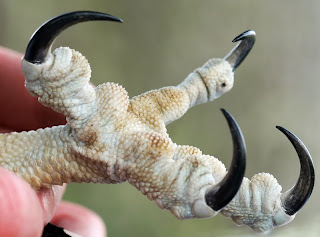Join World Bird Sanctuary as they celebrate Bald Eagle
season around the region!
At this time of year, the holidays are behind us, the
weather has turned cold and nasty, and we’re all looking for something to do
besides watch TV and hold down our recliners.
For those of us who live along the Mississippi flyway the
colder temperatures herald the arrival of some of the most admired and
magnificent creatures of them all.
No—not reindeer. This is
the season for eagle watching!
World Bird Sanctuary staff members and some of the eagles you may meet at our Eagle Days programs
The nearby rivers make for great eagle watching,
particularly near Locks and Dams.
Bald Eagles migrate south along the Mississippi River, looking for good
fishing in water that hasn’t frozen solid.
If you can bear braving the cold and wind along the river,
chances are that you will see wild Bald Eagles in action, hunting their prey,
perching in a tree, or soaring up above.
Eagle watching is an annual tradition for many of us, even those of us
that are lucky enough to see and work with them every day.
If you want to see a live bald eagle up close and in person,
you can visit the World Bird Sanctuary, or catch one of the displays or
presentations below:
Alton Visitor’s Center
Alton, IL
January 4, 11, 18, and 25
from 10 am – 2 pm
Eagle Meet & Greet
Meet a live bald eagle and talk to a naturalist to learn
about their habits, behaviors, and how they survived almost becoming extinct.
Lake of the Ozarks Eagle Days
Lake Ozark, MO
January 4 and 5
Hourly programs from 9-3 Saturday, from 10-2 Sunday
All About Eagles Programs, Traveling Talons Gift Shop
Did you know that Ben Franklin wanted the turkey as our
national symbol instead of the Bald Eagle? Get an up close and personal view of
a Bald Eagle and learn the reasons it was chosen instead of the turkey.
Audubon Center at Riverlands
West Alton, MO
January 5, 12, 19, 26, February 2, 9
10 am – 2 pm
Eagle Display
Ever meet a live bald eagle before? Join us for this fascinating
program. Learn about their habits,
behaviors, and how they survived almost becoming extinct.
Quad Cities Eagle Days
Rock Island, IL
January 10 - 12
Raptor Awareness programs with Eagle
Features birds of prey including falcons, hawks, owls and
vultures. Not only will you see different species of raptors, but you'll also
learn a vulture's secret weapon and how to identify a bird of prey in the wild.
Sit back and enjoy an up close view as some of the birds soar right over your
head! At the end of the program,
meet a live bald eagle!
Prairie Commons Branch Library
Hazelwood, MO
January 15
7:00 pm
All About Eagles Program
Join us for this fascinating look into the lives of
Eagles. Learn about their amazing
eyesight. Get a close-up view of
our national symbol.
Missouri Department of Conservation
Chain of Rocks Bridge
January 18 – 19
Programs from 9 am – 3 pm
All About Eagles Programs
Get an up close and personal view of our national symbol,
the Bald Eagle, and learn the reasons it was chosen as our national symbol instead of the turkey. Learn how the Bald Eagle came
back from the brink of extinction.
This may be your once-in-a-lifetime chance to get a good look at a Bald
Eagle from only a few feet away.
Keokuk Eagle Days
Keokuk, IA
January 18 and 19
Saturday: programs from 10:00 am – 4:00 pm
Sunday: programs from 11:00 am – 3:00 pm
Raptor Awareness Program with eagle
Do you know what happens if a vulture is attacked by another
predator? Learn the answer to that
question and many more at this program, which also features other birds of
prey, including falcons, hawks, owls and vultures. Learn how to identify a bird of prey in the wild. Sit back
and enjoy an up close view as some of the birds soar right over your head! At the end of the program, meet a live
bald eagle!
Clarksville Eagle Days
Clarksville, MO
January 25 and 26
Saturday: programs from 9:00 am – 4:00 pm
Sunday: programs from 10:00 am – 3:00 pm
All About Eagles Program
Where else can you get an up close and personal view of a
Bald Eagle and learn the reasons it was chosen for our national symbol instead
of the turkey. Did you know how to
tell the approximate age of a young Bald Eagle just by looking at its
feathers? Learn the answer to
these questions, and many more, at Clarksville Eagle Days.
Fort Bellefontaine Park
St. Louis, MO
January 25
12:00 pm – 2:00 pm
Four bird display featuring a bald eagle and other birds of
prey. Naturalists will be on hand
to talk about the animals and answer your questions.
National Great Rivers Museum
East Alton, IL
February 15 – 17
Shows at 11:00 am, 1:00 pm and 3:00 pm each day
Masters of the Sky Programs and Eagle Display
Join us for this fascinating program that features birds of
prey including falcons, hawks, owls and vultures. Learn about some of the
secret weapons possessed by vultures to evade other predators. In addition learn how to identify a
bird of prey in the wild. Sit back and enjoy an up close view as some of the
birds soar right over your head!
At the end of the program, meet a live bald eagle!
Lewis and Clark Confluence Tower
Hartford, IL
1:00 pm – 3:00 pm
Eagle Display
Have you ever seen a Bald Eagle from a few feet away? Meet a live bald eagle and talk to a
naturalist to learn about their habits, behaviors, and how they survived almost
becoming extinct.





































.jpg)









